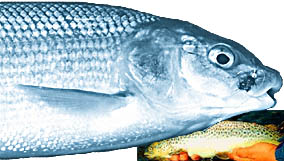Mountain whitefish
Love 'em and hate 'em
by Clive SchaupmeyerAdapted from The Essential Guide to Fly-Fishing by the author
A frustrated voice echos along western streams countless times each season, "Oh. It's just another !&@!#! whitefish!"
Then there are days when we are asked, "How'd ya do on the river yesterday?"
And we sheepishly reply, "Caught several fish ... wel
ologize to appease piscatorial gods.
It's the Canadian way - eh?

And so it goes. We hate rockies. We secretly love the
Mountain whitefish, Prosopium williamsoni (also wrongly called Rocky Mountain whitefish, or simply rockies) are common to many trout drainages in western Canada and the United States. Like arctic grayling they have the telltale adi
pose fin common to all members of the trout and salmon family. (You do know they are members of the trout and salmon family, don't you?)
Most trout fly anglers don't specifically fish for whitefish, but some anglers catch whitefish for the smoker. In Alberta we even allow the use of maggots in the fall on a few rivers just so non-fly-fishing types can catch them.
There would likely be more trout if the rockies didn't eat trout eggs. And perhaps in some rivers we'd be up to our wader tops in suckers if the whitefish also didn't eat sucker eggs. It's a fine balance that's existed for decades,
and since in many waters the mountain whitefish are native - and the trout are not - we shouldn't be questioning the big scheme of things too much. They are native and a part of a western trout angler's life. They have status and as such must be tolerate
d if not actually praised as a game fish.
Rockies fight fairly well and during the winter they usually scrap more than rainbows. This makes sense because they are native and rainbows are not, at least where I fish in southern Alberta, so they are naturally acclimatized to
the conditions. Early and late in the season it's common to catch a few rockies early in the day when the water is cooler and the rockies are feeding. Then after a couple of trout-less hours when the water has warmed, we'll catch rainbows and no more whit
efish. And that's okay.
There's not much to say about fly-fishing gear for mountain whitefish. Rockies are caught with trout gear. But you'll never hear, "Yup. I had this guy up in Calgary make the sweetest little 4-weight, mountain whitefish bamboo rod."
Mountain whitefish will come up to dry flies, but of the many dozens I've caught in the past decade only a handful were caught on dries. Rockies frustrate large numbers of fly anglers when they rise along with trout during a solid
insect hatch. It happened to me a few years ago on the Missouri River at Craig, Montana. Their rises tend to be quite splashy, but at first they pretty much look like, well ... trout rising. It takes a while to catch on to the differences, and frankly som
etimes there is precious little difference between a rockie's rise form and a trout's.
A few years ago, during a midge hatch in March, I cast to one quiet, sipping fish on the Crowsnest River. It was going to be the first rainbow of the year on a dry fly. I missed it a couple of times and let it rest until it started
feeding again. I finally hooked it and sure enough it was a whitefish. Any number of "experts" would have sworn it was a rainbow just poking its nose above the calm surface.
The vast majority of rockies I've hooked over the years were all caught while fishing for rainbows with small nymphs like our local favorite, Black Mink, which they love. They also eat small San Juan Worms, midge pupae patterns, an
d Hare's Ears. Just like trout.
Although they are clearly a secondary prey of fly anglers, there are times when I give up on uncooperative rainbows and try to catch rockies. We don't drive two hundred miles to catch mountain whitefish, but we try to salvage the o
ccasional trout trip when the trout are in a funk and we can't figure them out.
Return to Index
Copyright ©1998 Clive Schaupmeyer
Clive Schaupmeyer is an outdoor writer and photographer. He is the author of
The Essential Guide to Fly-Fishing,
a 288-page book for novice and intermediate fly anglers. His photo of a boy
fishing was judged the best outdoor picture of 1996 published by a member of
the Outdoor Writers of Canada. He fly-fishes for trout in Alberta's foothill
and mountain streams and for pike near his home in Brooks, Alberta.
Our Man In Canada Archives
|



